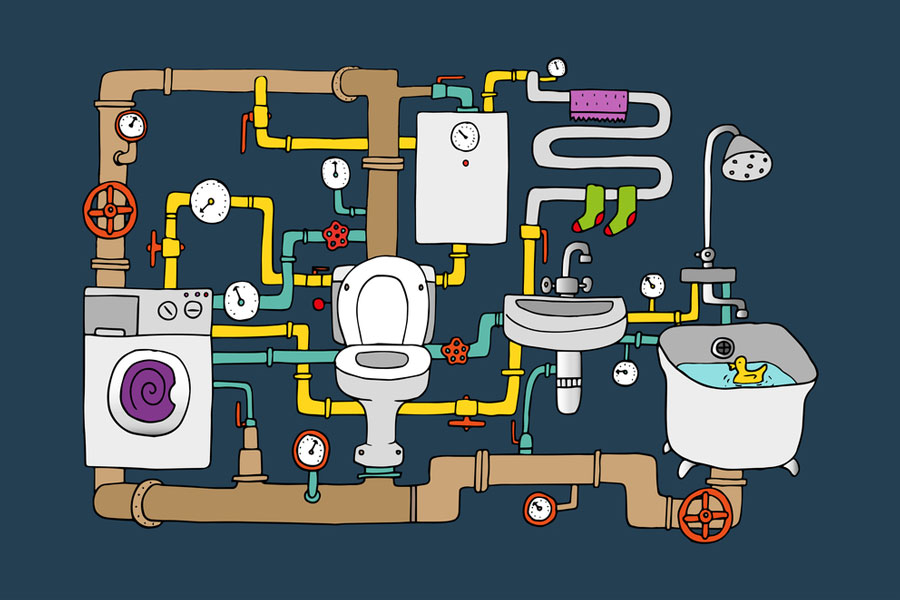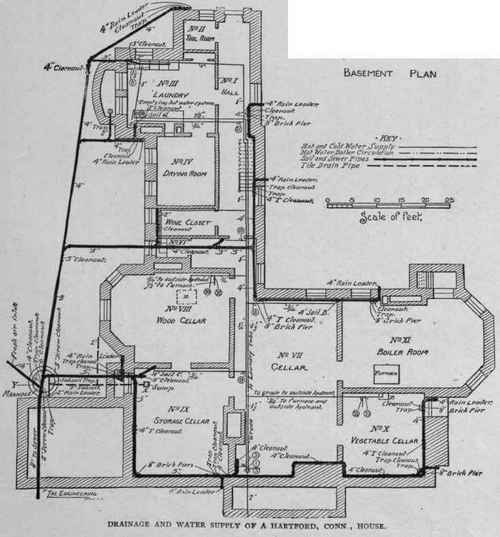The Basics to Your Property's Plumbing System Anatomy
The Basics to Your Property's Plumbing System Anatomy
Blog Article
We've noticed this article involving Understanding Your Home's Plumbing Anatomy directly below on the internet and concluded it made good sense to discuss it with you in this article.

Understanding how your home's plumbing system works is important for every homeowner. From delivering tidy water for drinking, cooking, and showering to safely removing wastewater, a properly maintained pipes system is important for your family's wellness and convenience. In this extensive guide, we'll explore the intricate network that composes your home's plumbing and deal ideas on maintenance, upgrades, and taking care of usual problems.
Introduction
Your home's pipes system is more than simply a network of pipelines; it's a complicated system that ensures you have access to tidy water and efficient wastewater elimination. Knowing its parts and exactly how they collaborate can assist you stop expensive repair work and ensure whatever runs efficiently.
Standard Components of a Pipes System
Pipes and Tubing
At the heart of your plumbing system are the pipelines and tubes that lug water throughout your home. These can be made of numerous materials such as copper, PVC, or PEX, each with its benefits in terms of durability and cost-effectiveness.
Components: Sinks, Toilets, Showers, etc.
Components like sinks, commodes, showers, and bathtubs are where water is used in your house. Comprehending just how these fixtures attach to the pipes system assists in diagnosing issues and planning upgrades.
Shutoffs and Shut-off Points
Valves control the circulation of water in your plumbing system. Shut-off shutoffs are essential throughout emergencies or when you require to make repair services, allowing you to isolate parts of the system without interfering with water flow to the whole house.
Water System
Key Water Line
The major water line links your home to the metropolitan supply of water or an exclusive well. It's where water enters your home and is distributed to different fixtures.
Water Meter and Pressure Regulatory Authority
The water meter steps your water use, while a stress regulator ensures that water flows at a risk-free pressure throughout your home's plumbing system, stopping damages to pipes and fixtures.
Cold Water vs. Hot Water Lines
Comprehending the distinction in between cold water lines, which provide water straight from the main, and hot water lines, which carry heated water from the hot water heater, aids in troubleshooting and planning for upgrades.
Drain System
Drain Pipes Piping and Traps
Drain pipelines carry wastewater away from sinks, showers, and commodes to the sewer or sewage-disposal tank. Traps avoid drain gases from entering your home and additionally trap debris that might trigger clogs.
Ventilation Pipes
Ventilation pipelines permit air right into the water drainage system, stopping suction that could slow water drainage and cause traps to empty. Correct air flow is essential for maintaining the stability of your pipes system.
Relevance of Correct Drain
Making sure correct water drainage protects against back-ups and water damages. Regularly cleaning up drains and preserving traps can stop expensive repair services and expand the life of your plumbing system.
Water Heater
Kinds Of Water Heaters
Water heaters can be tankless or standard tank-style. Tankless heating units warm water as needed, while storage tanks store warmed water for instant use.
How Water Heaters Attach to the Pipes System
Comprehending exactly how water heaters attach to both the cold water supply and hot water distribution lines aids in identifying problems like insufficient warm water or leaks.
Maintenance Tips for Water Heaters
Regularly purging your water heater to remove debris, inspecting the temperature setups, and examining for leakages can prolong its life expectancy and boost power efficiency.
Usual Plumbing Concerns
Leaks and Their Reasons
Leakages can occur as a result of aging pipelines, loose installations, or high water pressure. Resolving leaks without delay stops water damages and mold development.
Blockages and Obstructions
Clogs in drains and commodes are typically caused by purging non-flushable things or a buildup of grease and hair. Making use of drain displays and being mindful of what decreases your drains pipes can prevent clogs.
Signs of Plumbing Troubles to Look For
Low water stress, slow-moving drains pipes, foul odors, or abnormally high water costs are indications of prospective pipes problems that ought to be dealt with quickly.
Plumbing Maintenance Tips
Normal Assessments and Checks
Schedule annual plumbing inspections to capture problems early. Search for indicators of leaks, corrosion, or mineral accumulation in faucets and showerheads.
Do It Yourself Maintenance Tasks
Basic jobs like cleansing tap aerators, checking for commode leakages making use of color tablet computers, or insulating exposed pipes in chilly climates can prevent major pipes problems.
When to Call a Professional Plumbing Technician
Know when a pipes problem needs professional expertise. Trying complicated repairs without proper expertise can bring about even more damage and greater repair work costs.
Updating Your Plumbing System
Reasons for Updating
Upgrading to water-efficient fixtures or replacing old pipelines can enhance water top quality, reduce water bills, and increase the value of your home.
Modern Plumbing Technologies and Their Benefits
Explore technologies like smart leakage detectors, water-saving bathrooms, and energy-efficient water heaters that can conserve cash and lower ecological impact.
Expense Factors To Consider and ROI
Compute the ahead of time prices versus lasting savings when taking into consideration plumbing upgrades. Numerous upgrades pay for themselves through decreased utility expenses and fewer repair services.
Ecological Effect and Conservation
Water-Saving Fixtures and Devices
Installing low-flow taps, showerheads, and commodes can considerably reduce water use without giving up performance.
Tips for Minimizing Water Use
Straightforward routines like repairing leaks without delay, taking shorter showers, and running complete loads of laundry and meals can save water and lower your energy expenses.
Eco-Friendly Plumbing Options
Consider lasting pipes materials like bamboo for floor covering, which is durable and green, or recycled glass for kitchen counters.
Emergency situation Readiness
Steps to Take During a Pipes Emergency
Know where your shut-off shutoffs are located and how to turn off the water in case of a ruptured pipe or significant leakage.
Value of Having Emergency Contacts Convenient
Maintain contact details for local plumbers or emergency situation services conveniently available for quick reaction during a pipes crisis.
Do It Yourself Emergency Situation Fixes (When Appropriate).
Short-lived repairs like utilizing duct tape to patch a dripping pipe or positioning a pail under a leaking faucet can minimize damages until a specialist plumbing gets here.
Final thought.
Understanding the makeup of your home's plumbing system encourages you to maintain it properly, saving money and time on repairs. By following routine upkeep routines and remaining educated regarding modern-day plumbing modern technologies, you can ensure your pipes system operates successfully for many years ahead.
HOW YOUR PLUMBING SYSTEM WORKS
Which Pipes Do What?
Blue lines = fresh water supply entering the building
Red lines = hot water supply entering the building
Grey lines = pipes carrying waste away from the building and venting pipes carrying gases away from the building (through the roof)
YOUR MAIN PLUMBING SYSTEMS
There are two main plumbing systems that support your home s basic plumbing needs one that brings clean water into your home, and one that sends dirty water away from your home. Connected to the toilet, bath, shower, and other faucets in your home, these two systems keep your water flowing in the right directions.
ACCESSING FRESH WATER
Fresh and clean water is brought into your home through the main water supply line . Filtered through one pipe, this water is pressured to flow into the various fixtures in your home at any given time.
This water can be sourced from a well located on your property, a pond or river (mostly cottages), or, as in most cases, from the city s municipal water treatment centre. However, it is important to note that water that is untreated, such as the water siphoned from ponds or rivers, may not be safe to drink. Personal water supplies always need to be treated for hardness and contaminants before consumed.
MUNICIPAL WATER SUPPLIES
Improve taste and odour
Remove sediment
Eliminate hardness
Reduce chlorine
COLD WATER SUPPLY VS. HOT WATER SUPPLY
Cold water flows into your home or building through the service line, which then distributes hot or cold water to your fixtures. This line is most commonly run through a central column that runs floor to floor. Hot water runs in short and straight pipes as the longer the pipeline, the more heat that will be lost in the transfer. Having shorter pipes also allows residents to access hot water more quickly.
WASTE WATER SYSTEM
Your wastewater system is divided into two parts pipes that send wastewater away from your home and venting pipes that send sewer gas away from your home. Sewage water travels through pipes that flush the water and waste towards local sewers that are operated and managed by your city or town. Most sewer systems rely on gravity to move the wastewater to where it needs to go.
The further away from your toilet or sink, the larger wastewater pipes become. This allows for waste to be disposed of from various parts of your home or business at once without pipe blockages. The angle and flow of these pipes are also essential for keeping your waste pipes clear of build up.
https://harrisplumbing.ca/how-your-home-plumbing-system-works/

HOW YOUR PLUMBING SYSTEM WORKS
Which Pipes Do What?
YOUR MAIN PLUMBING SYSTEMS
There are two main plumbing systems that support your home s basic plumbing needs one that brings clean water into your home, and one that sends dirty water away from your home. Connected to the toilet, bath, shower, and other faucets in your home, these two systems keep your water flowing in the right directions.
ACCESSING FRESH WATER
Fresh and clean water is brought into your home through the main water supply line . Filtered through one pipe, this water is pressured to flow into the various fixtures in your home at any given time.
This water can be sourced from a well located on your property, a pond or river (mostly cottages), or, as in most cases, from the city s municipal water treatment centre. However, it is important to note that water that is untreated, such as the water siphoned from ponds or rivers, may not be safe to drink. Personal water supplies always need to be treated for hardness and contaminants before consumed.
MUNICIPAL WATER SUPPLIES
COLD WATER SUPPLY VS. HOT WATER SUPPLY
Cold water flows into your home or building through the service line, which then distributes hot or cold water to your fixtures. This line is most commonly run through a central column that runs floor to floor. Hot water runs in short and straight pipes as the longer the pipeline, the more heat that will be lost in the transfer. Having shorter pipes also allows residents to access hot water more quickly.
WASTE WATER SYSTEM
Your wastewater system is divided into two parts pipes that send wastewater away from your home and venting pipes that send sewer gas away from your home. Sewage water travels through pipes that flush the water and waste towards local sewers that are operated and managed by your city or town. Most sewer systems rely on gravity to move the wastewater to where it needs to go.
The further away from your toilet or sink, the larger wastewater pipes become. This allows for waste to be disposed of from various parts of your home or business at once without pipe blockages. The angle and flow of these pipes are also essential for keeping your waste pipes clear of build up.
https://harrisplumbing.ca/how-your-home-plumbing-system-works/
I stumbled upon that post about The Inner Workings of Your Home's Plumbing when doing a lookup on the search engines. If you please take a moment to share this blog entry if you liked it. Thank-you for your time invested reading it.
Request An Estimate Report this page